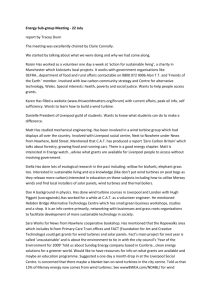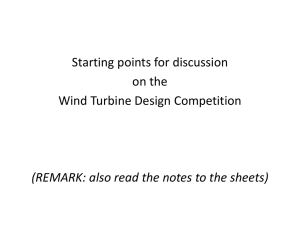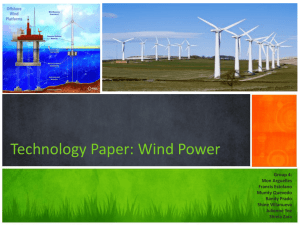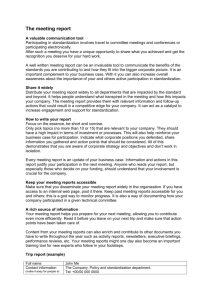Carew Research Paper
advertisement
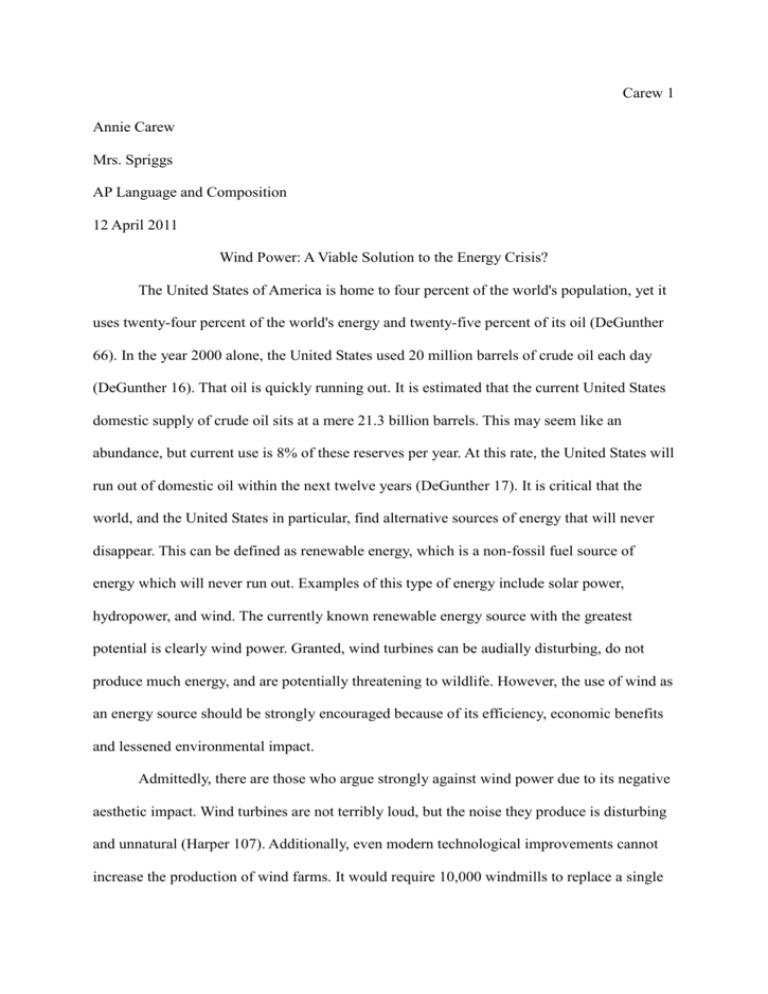
Carew 1 Annie Carew Mrs. Spriggs AP Language and Composition 12 April 2011 Wind Power: A Viable Solution to the Energy Crisis? The United States of America is home to four percent of the world's population, yet it uses twenty-four percent of the world's energy and twenty-five percent of its oil (DeGunther 66). In the year 2000 alone, the United States used 20 million barrels of crude oil each day (DeGunther 16). That oil is quickly running out. It is estimated that the current United States domestic supply of crude oil sits at a mere 21.3 billion barrels. This may seem like an abundance, but current use is 8% of these reserves per year. At this rate, the United States will run out of domestic oil within the next twelve years (DeGunther 17). It is critical that the world, and the United States in particular, find alternative sources of energy that will never disappear. This can be defined as renewable energy, which is a non-fossil fuel source of energy which will never run out. Examples of this type of energy include solar power, hydropower, and wind. The currently known renewable energy source with the greatest potential is clearly wind power. Granted, wind turbines can be audially disturbing, do not produce much energy, and are potentially threatening to wildlife. However, the use of wind as an energy source should be strongly encouraged because of its efficiency, economic benefits and lessened environmental impact. Admittedly, there are those who argue strongly against wind power due to its negative aesthetic impact. Wind turbines are not terribly loud, but the noise they produce is disturbing and unnatural (Harper 107). Additionally, even modern technological improvements cannot increase the production of wind farms. It would require 10,000 windmills to replace a single Carew 2 power plant (Harper 107). Considering that turbines must be placed in the some of the most visible areas, such as hilltops, in order to be effective, placing 10,000 of them in one area would arguably destroy that area's natural beauty. Since wind does not produce much energy (Harper 108), is it worth it to install so many turbines? There are those who would argue that the cost of replacing current fossil-fuel plants with wind turbines would not be a worthwhile financial investment. Moreover, the size and abundance of such turbines may be threatening to wildlife. It is currently estimated that over 40,000 birds, many in the process of migrating north or south, are killed each year by the blades of windmills (Miller and Spoolman 421). Such an attitude towards wind farming and other renewable sources is frequently referred to NIMBY, or Not in My Backyard. (Harper 110). Such individuals do not wish to have their own backyards or pristine views spoiled by wind turbines and their disruptive noise. It is these persons with NIMBY attitudes who most strongly oppose the use of wind power in the United States and elsewhere. To summarize, the opponents of wind power believe that it is inconvenient to install turbines due to the sheer number of them which would be needed, which would additionally disturb nearby residents with the turbines' unnatural sound, as well as potentially harm or kill migratory birds. However, the benefits of wind far outweigh these minor costs, especially newfound wind efficiency, the economic benefits, and the environmental impact, or lack thereof. Initially, the use of wind power should be more widespread because of the efficiency of wind farms. For instance, a modern wind turbine can produce 100 kilowatts of energy (Harper 107). This is a vast improvement on earlier windmills, the first of which appeared around 2,000 years ago in China. Wind turbines were first used to produce electricity in 1890, and the result was only about twelve kilowatts of power (DeGunther 192). Obviously, the production level of a single turbine has improved dramatically since that time. Likewise, the Carew 3 use of wind turbines can be combined with traditional land uses (Harper 112), such as grazing cattle or growing crops beneath the spinning blades. Moreover, a single offshore wind farm near Cape Cod produces 420 megawatts of energy per year, which is enough electricity to power over 200,000 homes in New England (DeGunther 196). Offshore wind farms are especially ideal because they are far enough away from the shore not to be visible to the naked human eye, which effectively removes the NIMBY idea about wind farms spoiling natural beauty for human enjoyment. Additionally, offshore winds are more constant and stronger than those over land, and the ecological impact of wind farms is reduced because few organisms live in the open ocean (DeGunther 196). Based on this research, the efficiency of wind power has been vastly improved in recent years. The multiple ways to use land which houses wind turbines ensures land efficiency; land is another valuable resource humans should take care not to squander. Moreover, offshore wind farms are a particularly efficient branch of wind farming that should be further cultivated. To summarize, since wind farming is now proven to be much more efficient, why should the United States, and the rest of the world, not use it more frequently? Furthermore, the economic potential of wind power is vast and exciting. To illustrate, wind plants provide 70% more jobs than do natural gas plants, which are currently in common use (Kerry 177). These jobs stem from the employment of construction workers, as well as many permanent employees in charge of keeping the plant running smoothly. In addition, a single wind turbine stationed on a quarter of an acre can produce $300,000 worth of electricity per year (Miller and Spoolman 421). This could be extremely beneficial to farmers with vast tracts of land on which they graze stock or grow crops. As discussed above, this same land could be used for wind farming, which would provide additional income. Moreover, “in 2006, renewable energy and energy-efficient technologies generated 8.5 Carew 4 million new jobs, nearly $970 billion in revenue, and more than $100 billion in industry profits” (Jones 5). These are massive figures which simply cannot be ignored, especially when the potential economic benefits are carefully considered. Such a wonderful source of income as well as power should be welcomed in these difficult economic times, rather than rejected. This is especially true because these difficult times are exacerbated by the U.S.'s dependence on foreign oil. For example, the manufacturing of petroleum uses 7% of U.S. energy consumption (DeGunther 61). Clearly, it takes energy to produce energy, as well as every other product in existence. As the cost of energy goes up, so does the cost of everything else (Jones 1). The United States possessed a $483 billion trade deficit in 2002; 24% of that deficit was due to the import of various energy sources. Why squander so much money? Contrary to the costs of oil, the cost of wind power has actually gone down in recent years. Electricity produced via wind turbines cost forty cents per kilowatt-hour in 1982. In the 2000s, the cost of wind power has gone done to a mere four cents per kilowatt-hour (DeGunther 194). Obviously, wind power could provide massive economic benefits to the United States. A great deal of money could be saved by switching and encouraging renewable energy sources such as wind. From this research, it is abundantly clear that wind energy is one of the most cost-effective and economically beneficial sources of energy available today, and should definitely be used as often as possible. Ultimately, wind power is an excellent source of energy because it reduces the environmental impact of human energy production. In particular, wind turbines and wind farms produce no greenhouse gases at all, and there is no pollution created by transporting fuel or waste from such farms (DeGunther 201). This greatly reduces potentially harmful carbon dioxide emissions, as well as emissions of other dangerous gases. Additionally, if the United States were to harness a mere 10% of its wind power potential, 600 coal-burning Carew 5 power plants could be shut down (DeGunther 197). Of all the fossil fuels currently in use, coal is by far the dirtiest to burn. Similarly, although only 6% of the continental United States is suitable for wind farms, these areas could produce 1.5 times the current United States energy needs (Kerry 177). Furthermore, if one-fifth of the world's best wind sites were equipped with turbines, seven times the amount of energy currently used by the entire world could be produced (Miller and Spoolman 420). Why waste such a precious source? To illustrate further, the four states of North Dakota, South Dakota, Texas, and Kansas have been referred to as the “Saudi Arabia of wind power.” These four states alone could produce three times the amount of electricity currently used by the United States (Miller and Spoolman 420). Clearly, the benefits of such a clean, productive energy source are nearly endless. In summation, the use of wind as a major energy source should be strongly encouraged because of its efficiency, economic potential, and nearly nonexistent environmental impact. This idea is explained in detail by Peter Harper, a essayist who lives in Wales and strongly supports wind power. Harper points out that the costs of wind power are paid now rather than later; a wind turbine's only negative impact is that of aesthetics, and that effect is instantaneous: the sight and sound of a wind turbine are appalling to some persons. However, the only individual paying those costs is the one viewing the turbine and thinking to him- or herself how unattractive it is. On the other hand, the emissions from fossil fuels affect the rest of the world rather than only their users, as the pollution is spread across the world by prevailing winds. In addition, future generations will continue to pay the price of current pollution and environmental harm (Harper 110). The effects of air pollution on human health include diseases such as lung cancer, bronchitis, asthma, and emphysema (Miller and Spoolman 486). When comparing environmental, health, and aesthetic impacts, wind power only produces an immediate aesthetic impact (Harper 110). In other words, the impact Carew 6 produced by wind power is negligible compared with polluting fossil fuels. To recapitulate, wind power is the best available source of renewable energy because it is efficient, economically viable, and not at all harmful to our planet. Clearly, this is the path that the world should take in its energy production. Wind is by far the best option. Carew 7 Works Cited Cothran, Helen, ed. Opposing Viewpoints: Energy Alternatives. San Diego, CA: Greenhaven Press, 2002. Print. DeGunther, Rik. Alternative Energy for Dummies . Indianapolis, IN: Wiley Publishing, Inc. , 2009. Print. Jones, Van. The Green Collar Economy: How One Solution Can Fix Our Two Biggest Problems. New York, NY: HarperCollins Publishers, 2998. Print. Kerry, John, and Teresa Heinz Kerry. This Moment on Earth: Today's New Environmentalists and Their Vision for the Future. New York, NY: PublicAffairs, 2007. Print. Miller, G. Tyler, and Scott E. Spoolman. Living in the Environment. 16th ed. Belmont, CA: Brooks/Cole, Cengage Learning, 2009. Print.



